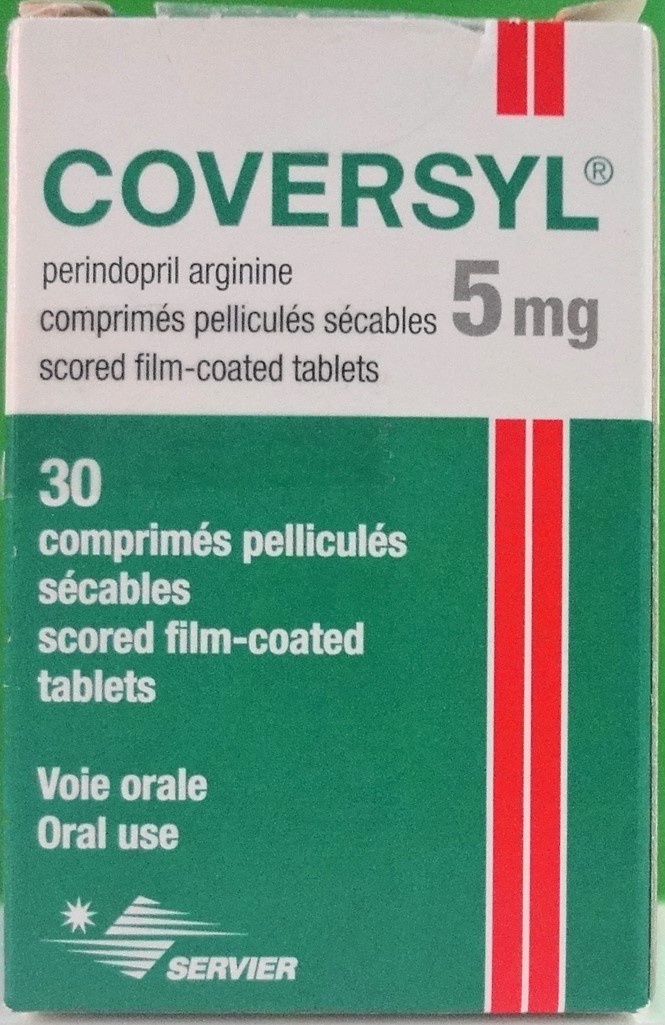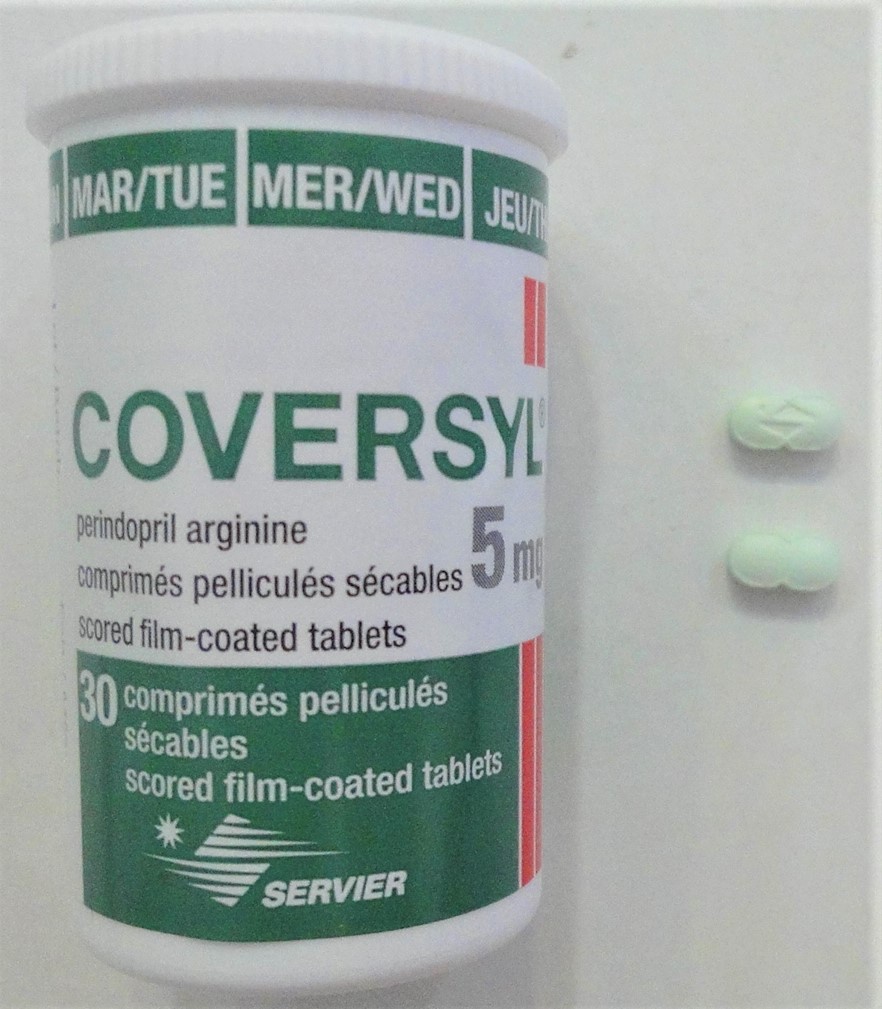COVERSYL 5mg Tablet
ក្រុមហ៊ុនផលិតឱសថ:
Les Laboratoires Servier Industrie, France
ក្រុមហ៊ុនចែកចាយឱសថនៅប្រទេសកម្ពុជា:
DKSH


- សារធាតុសកម្ម
- ប្រសិទ្ធិភាពព្យាបាល និង កម្រិតប្រើប្រាស់
- ហាមប្រើ
- ផលរំខាន
- អន្តរប្រតិកម្ម
- ស្ត្រីមានផ្ទៃពោះ និង ស្ត្រីបំបៅដោះកូន
- ការប្រុងប្រយ័ត្នជាពិសេស
- សកម្មភាពឱសថ បរិយាយប័ណ្ណឱសថ
-
សារធាតុសកម្ម
-
ប្រសិទ្ធិភាពព្យាបាល និង កម្រិតប្រើប្រាស់
គុណភាពព្យាបាល
ឱសថនេះប្រើសំរាប់ព្យាបាល:
- ជម្ងឺសម្ពាធឈាមឡើងបណ្ដាលពីសរសៃឈាម
- រោគសញ្ញានៃជម្ងឺខ្សោយសាច់ដុំបេះដូង
- ជម្ងឺរឹងឬក្រិនសរសៃឈាមចិញ្ចឹមបេះដូង។
កំរិតនិងរបៀបប្រើ
- ឱសថនេះប្រើចំពោះតែមនុស្សពេញវ័យប៉ុណ្ណោះ
- កំរិតប្រើប្រចាំថ្ងៃប្រែប្រួលពី 2.5 ទៅ 10 ម.ក្រ ក្នុង1ថ្ងៃ
- អ្នកជម្ងឺត្រូវអនុវត្តតាមការណែនាំរបស់វេជ្ជបញ្ជារបស់គ្រូពេទ្យអោយបានត្រឹមត្រូវ
- កំរិតប្រើដំបូងនិងកំរិតប្រើក្នុងការព្យាបាលប្រែប្រួលទៅតាមសភាពជម្ងឺឬអ្នកជម្ងឺកំពុងប្រើឱសថផ្សេងទៀត
- ត្រូវពិគ្រោះជាមួយគ្រូពេទ្យឬឱសថការី ក្រោយពេលប្រើឱសថនេះ ហើយអ្នកយល់ថាឱសថនេះមានប្រសិទ្ធភាពខ្លាំងពេកឬខ្សោយពេក
- ឱសថនេះប្រើសំរាប់លេបតាមមាត់
- មនុស្សពេញវ័យ: ប្រើ1គ្រាប់ 1ដងក្នុង1ថ្ងៃ (លេបពេលព្រឹក មុនពេលបរិភោគអាហារ)។
Indication
Coversyl is used:
- to treat high blood pressure (hypertension),
- to treat heart failure (a condition where the heart is unable to pump enough blood to meet the body's needs)
- to reduce the risk of cardiac events, such as heart attack, in patients with stable coronary artery disease (a condition where the blood supply to the heart is reduced or blocked) and who have already had a heart attack and/or an operation to improve the blood supply to the heart by widening the vessels that supply it.
Dosage
- High blood pressure: the usual starting and maintenance dose is 5mg once daily. After one month, this can be increased to 10mg once a day if required. 10mg a day is the maximum recommended dose for high blood pressure. If you are 65 or older, the usual starting dose is 2.5mg once a day. After a month this can be increased to 5mg once a day and then if necessary to 10mg once daily.
- Heart failure: the usual starting dose is 2.5mg once daily. After two weeks, this can be increased to 5mg once a day, which is the maximum recommended dose for heart failure.
- Stable coronary artery disease: the usual starting dose is 5mg once daily. After two weeks, this can be increased to 10mg once daily, which is the maximum recommended dose in this indication. If you are 65 or older, the usual starting dose is 2.5mg once a day. After a week this can be increased to 5mg once a day and after a further week to 10mg once daily.
-
ហាមប្រើ
ហាមប្រើ:
- ចំពោះអ្នកជម្ងឺធ្លាប់អាល្លែកហ្ស៊ីជាមួយសារធាតុផ្សំណាមួយនៃសារធាតុនេះ ឬជាមួយពួកឱសថACE inhibitorផ្សេងទៀត
- ចំពោះអ្នកធ្លាប់ប្រតិកម្មអាល្លែកហ្ស៊ីហើមមុខនិងក (Quinck's oedema) ដោយការប្រើពួកឱសថACE inhibitor
- ចំពោះអ្នកជម្ងឺតពូជ ឬ idiopathic Quink's oedema
- ស្ត្រីមានផ្ទៃពោះ ក្នុងដំណាក់កាលត្រីមាសទី2និងទី3។
- if you are allergic to perindopril or any of the other ingredients of this medicine, or to any other ACE inhibitor
- if you have experienced symptoms such as wheezing, swelling of the face, tongue or throat, intense itching or severe skin rashes with previous ACE inhibitor treatment or if you or a member of your family have had these symptoms in any other circumstances (a condition called angioedema).
- if you are more than 3 months pregnant (it is also better to avoid Coversyl in early pregnancy).
- if you have diabetes or impaired kidney function and patients are treated with a blood pressure lowering medicine containing aliskiren.
-
ផលរំខាន
ផលរំខានខ្លះៗ:
- ក្នុងពេលប្រើឱសថនេះអាចបណ្ដាលអោយ: ឈឺក្បាល សភាពធីងធោង វិលមុខ អារម្មណ៍ឆេវឆាវ មានការឈឺចាប់ឆៀបៗ ព្រិលភ្នែក ហ៊ឹងត្រចៀក សម្ពាធឈាមចុះ ក្អកស្ងួត ពិបាកដកដង្ហើម វិបត្តិផ្លូវរំលាយអាហារ(ចង្អោរ ឈឺក្នុងពោះ) វិបត្តិការដឹងរសជាតិ អស់កម្លាំង ស្បែកឡើងកន្ទួលក្រហម រមាស់ រមួលសាច់ដុំ(រមួលក្រពើ)
- លទ្ធផលតេស្តនៃមន្ទីរពិសោធន៍ប្រែប្រួល:
+ដោយកម្រ:កំរិត haemoglobin ថយចុះ កំរិតប៉ូតាស្យូមក្នុងឈាមកើនឡើង កំរិតអង់ហ្ស៊ីមរបស់ថ្លើមកើនឡើង កំរិតសេរ៉ូមbilirubinកើនឡើង
+កើនឡើងនៅក្នុងឈាមនូវកំរិតជាតិអ៊ុយរេ(Urea)និងកំរិតcreatinine។
- ត្រូវបញ្ឈប់ការប្រើឱសថ និងពិគ្រោះជាមួយគ្រូពេទ្យជាបន្ទាន់ក្នុងករណីមានការកើតឡើងនូវរោគសញ្ញា ហើមមុខ ហើមបបូរមាត់ ហើមអណ្ដាត មានបញ្ហាបំពង់កដែលបណ្ដាលអោយពិបាកដកដង្ហើមនិងពិបាលលេបអាហារ។
Stop taking the medicinal product and see a doctor immediately, if you experience any of the following side effects that can be serious:
- Uncommon: swelling of the face, lips mouth, tongue or throat, difficulty in breathing (angioedema),
- Common: severe dizziness or fainting due to low blood pressure,
- Very rare: unusual fast or irregular heart-beat, chest pain (angina) or heart attack, weakness of arms or legs, or problems speaking which could be a sign of a possible stroke,
- Uncommon: sudden wheeziness, chest pain, shortness of breath, or difficulty in breathing (bronchospasm),
- Very rare: inflamed pancreas which may cause severe abdominal and back pain accompanied with feeling very unwell, yellowing of the skin or eyes (jaundice) which could be a sign of hepatitis, skin rash which often starts with red itchy patches on your face, arms or legs (erythema multiforme).
Tell your doctor if you notice any of the following side effects:
- Common: headache, dizziness, vertigo, pins and needles, vision disturbances, tinnitus (sensation of noises in the ears), cough, shortness of breath (dyspnoea), gastro-intestinal disorders (nausea, vomiting, abdominal pain, taste disturbances, dyspepsia or difficulty f digestion, diarrhoea, constipation), allergic reactions (such as skin rashes, itching), muscle cramps, feeling of weakness.
- Uncommon: mood swings, sleep disturbances, dry mouth, intense itching or severe skin rashes, formation of blister clusters over the skin, kidney problems, impotence, sweating, excess of eosinophils (a type of blood vessels), photosensitivity reaction (increased sensitivity of the skin to sun), arthralgia (joint pain), myalgia (muscle pain), chest pain, malaise, oedema peripheral, fever, fall, change in laboratory parameters (high blood level of potassium reversible on discontinuation, low level of sodium, hypoglycaemia (very low blood sugar level) in case of diabetic patients, increased blood urea, and increased blood creatinine).
- Rare: changes in laboratory parameters (increased level of liver enzymes, high level of serum bilirubin).
- Very rare: confusion, eosinophilic pneumonia (a rare type of pneumonia), rhinitis (blocked up or runny nose), acute renal failure, changes in blood values such as a lower number of white and red blood cells, lower haemoglobin, lower number of blood platelets,
-
អន្តរប្រតិកម្ម
អន្តរកម្មឱសថ:
- ក្នុងពេលប្រើឱសថនេះមុនប្រើឱសថផ្សេងទៀត ត្រូវពិគ្រោះជាមួយគ្រូពេទ្យឬឱសថការី។ ជាពិសេសពួកឱសថដែលមានសារធាតុប៉ូតាស្យូម (Potassium-sparing diuretics, potassium salts and lithium) ឬពួកឱសថដែលប្រើដោយមិនមានវេជ្ជបញ្ជាក៏ដោយ។
Treatment with Coversyl can be affected by other medicines. Doctor may need to change the patient’s dose and/or to take other precautions. These include:
- other medicines for high blood pressure, including angiotensinⅡreceptor blocker (ARB), aliskiren, or diuretics (medicines which increase the amount of urine produced by the kidneys),
- potassium-sparing drugs (e.g. triamterene, amiloride), potassium supplements or potassium-containing salt substitutes,
- potassium-sparing drugs used in the treatment of heart failure: eplerenone and spironolactone at doses between 12.5mg to 50mg by day,
- lithium for mania or depression,
- NSAIDs (e.g. ibuprofen) for pain relief or high dose aspirin,
- medicines to treat diabetes (such as insulin or metformin),
- baclofen (used to treat muscle stiffness in diseases such as multiple sclerosis),
- medicines to treat mental disorders such as depression, anxiety, schizophrenia etc. (e.g. tricyclic antidepressants, antipsychotics),
- immunosupressants (medicines which reduce the defence mechanism of the body) used for the treatment of auto-immune disorders or following transplant surgery (e.g. ciclosporin, tacrolimus),
- trimethoprim (for the treatment of infections),
- estramustine (used in cancer therapy),
- allopurinol (for the treatment of gout),
- procainamide (for the treatment of an irregular heart beat),
- vasodilators including nitrates (products that make the blood vessels become wider),
- heparin (medicines used to thin blood),
- medicines used for the treatment of low blood pressure, shock or asthma (e.g. ephedrine, noradrenaline or adrenaline),
- gold salts, especially with intravenous administration (used to treat symptoms of rheumatoid arthritis).
Coversyl with food and drink
It is preferable to take Coversyl before a meal.
-
ស្ត្រីមានផ្ទៃពោះ និង ស្ត្រីបំបៅដោះកូន
・ឱសថនេះគួរជៀសវាងប្រើចំពោះស្ត្រីមានផ្ទៃពោះក្នុងត្រីមាសទី1 និង ស្ត្រីបំបៅកូន
・ហាមប្រើចំពោះស្ត្រីមានផ្ទៃពោះ ក្នុងដំណាក់កាលត្រីមាសទី2និងទី3។
Pregnancy and breast-feeding
If you are pregnant or breast-feeding, think you may be pregnant or are planning to have a baby, ask your doctor or pharmacist for advice before taking this medicine.
Pregnancy
You must tell your doctor if you think you are (or might become) pregnant. Your doctor will normally advise you to stop taking Coversyl before you become pregnant or as soon as you know you are pregnant and will advise you to take another medicine instead of Coversyl. Coversyl is not recommended in early pregnancy, and must not be taken when more than 3 months pregnant, as it may cause serious harm to your baby if used after the third month of pregnancy.
Breastfeeding
Tell your doctor if you are breast-feeding or about to start breast-feeding. Coversyl is not recommended for mothers who are breast-feeding, and your doctor may choose another treatment for you if you wish to breast-feed, especially if your baby is newborn, or was born prematurely.
-
ការប្រុងប្រយ័ត្នជាពិសេស
ការប្រុងប្រយ័ត្ន:
- ឱសថនេះគួរជៀសវាងប្រើចំពោះកុមារ និងក្មេងជំទង់
- ឱសថនេះគួរជៀសវាងប្រើចំពោះស្ត្រីមានផ្ទៃពោះក្នុងត្រីមាសទី1 និង ស្ត្រីបំបៅកូន
- ឱសថនេះគួរជៀសវាងប្រើក្នុងពេលជាមួយគ្នា និងពួកឱសថដែលមានសារធាតុប៉ូតាស្យូម (Potassium sparing diurectic, Potassium salts, and Lithium)
- ក្នុងពេលប្រើឱសថនេះអាចបណ្ដាលអោយក្អកស្ងួត។ ក្នុងករណីនេះអ្នកជម្ងឺត្រូវពិគ្រោះជាមួយគ្រូពេទ្យ ដើម្បីសំរេចថាគួរប្រើបន្តទៀត ឬ បញ្ឈប់ការប្រើឱសថនេះ
- ក្នុងពេលប្រើឱសថនេះអាចបណ្ដាលអោយមានគ្រោះថ្នាក់ដោយប្រតិកម្មអាល្លែកហ្ស៊ី ដូចជាហើមមុខ ហើមបំពង់សម្លេង និងហើមបំពង់ខ្យល់
- គ្រោះថ្នាក់នៃប្រតិកម្មអាល្លែកហ្ស៊ីចំពោះអ្នកជម្ងឺកំពុងព្យាបាលបំបាត់ប្រតិកម្មដែលបង្កដោយសត្វល្អិតទិចឬខាំ
- គ្រោះថ្នាក់នៃប្រតិកម្មអាល្លែកហ្ស៊ីចំពោះអ្នកជម្ងឺប្រឈមនឹងការលាងឈាម
- ត្រូវពិគ្រោះជាមួយគ្រូពេទ្យក្នុងករណីដូចខាងក្រោម: មានជម្ងឺសម្ពាធឈាមចុះ(មាសភាពធីងធោង ឬ វិលមុខ) តមប្រៃឬបានប្រើឱសថបញ្ចុះទឹកនោមរយៈពេលយូរ ខ្សោយបេះដូងឬតម្រងនោមឬថ្លើម សរសៃអាកទែរតម្រងនោមមានសភាពរួមតូច(បាត់បង់ភាពយឺត) ប្រើសំរាប់បេះដូងមានសភាពរួមតូច សរសៃឈាមអាកទែរមានសភាពក្រិនឬស្ពឹក(សរសៃឈាមអាកទែររួមតូចចង្អៀត) មានជម្ងឺទឹកនោមផ្អែម
- ក្នុងករណិមានការវះកាត់អ្នកជម្ងឺត្រូវជំរាបអ្នកដាក់ថ្នាំសណ្ដំថាកំពុងប្រើឱសថនេះ
- ដោយឱសថនេះមានសារធាតុLactose ដូច្នេះគួរជៀសវាងប្រើចំពោះអ្នកមានជម្ងឺតពូជដែលមានវត្តមានgalactoseក្នុងឈាម ឬ មានវិបត្តិនៃការជ្រាបglucoseនិងgalactoseឬមានជម្ងឺកង្វះអង់ហ្ស៊ីមLactase
- គួរជៀសវាងប្រើឱសថនេះ ក្នុងពេលបញ្ជាយានយន្តឬគ្រឿងម៉ាស៊ីនឬត្រូវប្រុងប្រយ័ក្នុងក្នុងពេលប្រើឱសថនេះ។
If any of the following apply, talk to doctor or pharmacist or nurse before taking Coversyl if patient:
- have aortic stenosis (narrowing of the main blood vessel leading from the heart) or hypertrophic cardiomyopathy (heart muscle disease) or renal artery stenosis (narrowing of the artery supplying the kidney with blood),
- have any other heart problems,
- have liver problems,
- have kidney problems or if you are receiving dialysis,
- suffer from a collagen vascular disease (disease of the connective tissue) such as systemic lupus erythematosus or scleroderma,
- have diabetes,
- are on a salt restricted diet or use salt substitutes which contain potassium,
- are to undergo anaesthesia and/or major surgery,
- are to undergo LDL apheresis (which is removal of cholesterol from blood by a machine),
- are going to have desensitization treatment to reduce the effects of an allergy to bee or wasp stings,
- have recently suffered from diarrhoea or vomiting, or are dehydrated,
- have been told by doctor that the patient have an intolerance to some sugars,
- are taking any of the following medicines used to treat high blood pressure:
- an “angiotensinⅡreceptor blocker” (ARBs) (also known as sartans - for example valsartan, telmisartan, irbesartan), in particular if you have diabetes-related kidney problems.
- aliskiren.
Doctor may check patient’s kidney function, blood pressure, and the amount of electrolytes (e.g. potassium) in blood at regular intervals.
- are of black origin since patients may have a higher risk of angioedema and this medicine may be less effective in lowering patient’s blood pressure than in non-black patients.
Angioedema
Angioedema (a severe allergic reaction with swelling of the face, lips, tongue or throat with difficulty in swallowing or breathing) has been reported in patients treated with ACE inhibitors. This may occur at any time during treatment. If the patient develops such symptoms, he/she should stop taking Coversyl and see a doctor immediately.
If you think the patient (or might become) pregnant. Coversyl is not recommended in early pregnancy, and must not be taken if the patient is more than 3 months pregnant, as it may cause serious harm to her baby if used at that stage.
Children and adolescents
The use of perindopril in children and adolescents up to the age of 18 years is not recommended.
-
សកម្មភាពឱសថ
ជាប្រភេទឱសថដែលមានប្រសិទ្ធភាពទប់ស្កាត់អង់ហ្ស៊ីម angiotensin converting (ACE inhibitor)។
COVERSYL is an angiotensin converting enzyme (ACE) inhibitor. Those work by widening the blood vessels, which makes it easier for heart to pump blood through them.
*ព័ត៌មានឱសថត្រូវបានរៀបរៀងដោយ អ៊ីម៉ាតុគឹ មេឌីក (ខេមបូឌា) ដោយផ្អែកលើប្រភពព័ត៌មានខាងក្រោម។ សម្រាប់ព័ត៌មានលម្អិត សូមស្វែងរកនៅក្នុងក្រដាសព័ត៌មាននៃឱសថនីមួយៗ ឬ សាកសួរទៅកាន់ក្រុមហ៊ុនឱសថឬតំណាងចែកចាយនៃឱសថនីមួយៗ។
ប្រភពព័ត៌មាន៖
- ក្រដាសព័ត៌មាននៃឱសថសម្រាប់អ្នកជំនាញវេជ្ជសាស្ត្រដែលប្រើប្រាស់នៅប្រទេសជប៉ុន (Pharmaceutical and Medical Devices Agency, Pmda): https://www.pmda.go.jp
- ព័ត៌មានសង្ខេបនៃឱសថសម្រាប់អ្នកជំងឺដែលប្រើប្រាស់នៅប្រទេសជប៉ុន: http://www.rad-ar.or.jp
